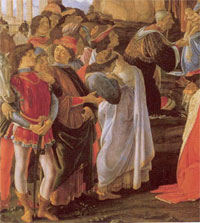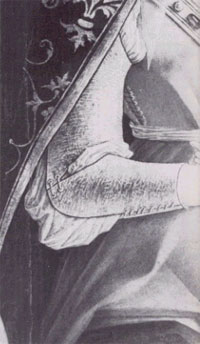

 |
 |
 |
 |
 |

|
|
|||||||||||
 |
|||||||||||
|
Figure 8:
an example of a colored poste
|
|||||||||||
 |
 |
||||||||||
| Figures 9 and 10: show white poste or sottoposte around the waists of these ladies. Figure 9 also offers an example of metal eyelets used for lacing holes. | |||||||||||
| Traditionally regulated to be two quartexiv wide (about 12 inches), there was a growing movement to produce a narrower version. This new sottoposte which eventually gained government recognition in the early 16th century, were only one and one half quarte wide (about 8 inches). The popularity of these sottoposte is undeniable with more than 24,000 bolts being exported annually into the early 16th centuryxv. I have yet to find any documentation about the length of the poste, although based on some of the examples in this document, they seem to be two or three yards long. There seem to be different lengths depending on the style of wear. Earlier in the century, they seem to be longer for that drapey, flowing effect, while later they seem to be shorter, just long enough to wrap twice around the waist. | |||||||||||
| Just from my own recent observations, I have found many examples of white poste, and I have also found examples of black poste, however, most of these have been from later 16th century paintings. However, there is one example of an orange poste in The Adoration of the Magi, by Botticelli (Figure 8). Anderson talks about Infanta Isabel, in 1483, having a faja or sash made from green, crimson and black silk. Anderson also discusses sashes made from velvet, and additional colors of mulberry, blue and yellow. Apparently black was most popular in Queen Isabel's household. In the last decade of the century, in Spain at least, they also had embellishment of their own. Decorative strips of black velvet, gold and silk embroidery, and gold tassels are only a few examples. | |||||||||||
| They seem to be wrapped around the waist twice, (maybe more if the fabric was very fine) often with no evidence of dangling ends. I suppose the ends were tucked back under the body of the poste. Some examples where ends are seen have fringe. If indeed these poste were made from the same fabric as veils of that period, then I would think they would have to be fairly sheer. The majority of the veils seen in paintings seem to be really fine based on the manner in which they "crush". | |||||||||||
| I was thrilled to finally find some documentation on an object that seemed to be an unrecognized phenomenon. For the many years that I had been considering 15th century Italian paintings, I have noticed the occasional dress that seemed to have a separation between the skirt and the bodice, as seen in Figure 10. While no one can say for sure that there were or were not gamurre made that way; I feel that they were probably not separated at the waist. I believe that this would have precipitated many fitting challenges. These dresses don't have any evidence of fitting differences from the obviously one-piece counterparts. | |||||||||||
| I came across the definition of the poste in the glossary of Luca Mola's bookxvii. It at least gave a name to the unusual belt some seemed to wear. According to Sr. Mola, the poste and sottoposte were common for all classes and indeed both sexes. "Poste were a sort of light veil related to sendalsxviii, sometimes made like nets and usually worn around the waist as belts by merchants, shopkeepers, boatmen, and above all by women and courtesans. One of the lesser known but most typical products of Renaissance Venice…" Apparently there was some controversy over the width of these poste. It seems that the width preference was dictated by the fashion tastes of the importing country. Countries like Germany, Hungary and France seemed to prefer narrower poste than the domestic customers in Venice. This eventually brought about the official recognition of the sottoposte. Beforehand, the Senate saw no reason to regulate the width, content or density of these fabrics. They gave the producers the freedom to follow the demands of the ever-changing European fashion. There were also concerns for the Venetian government in regards to the content of these sendals. Of course, Venetian pride dictated that only the first grade silk be used in these sendals because of their fine texture. However, as popularity gained, the production entrepreneurs saw their chance to increase their revenue by mixing waste silk or other fibers with the prime silk. As a result, this was forbidden by the Senate and "could not contain mailfillixix of any kind but only good silks...xx I had only come across this "poste revelation" a few weeks ago, so my knowledge is somewhat limited. Armed with this new information, I hope to further investigate this accessory and make it more commonly known. | |||||||||||
 |
|||||||||||
|
Figure 11:
several men wearing poste around their waist
|
|||||||||||